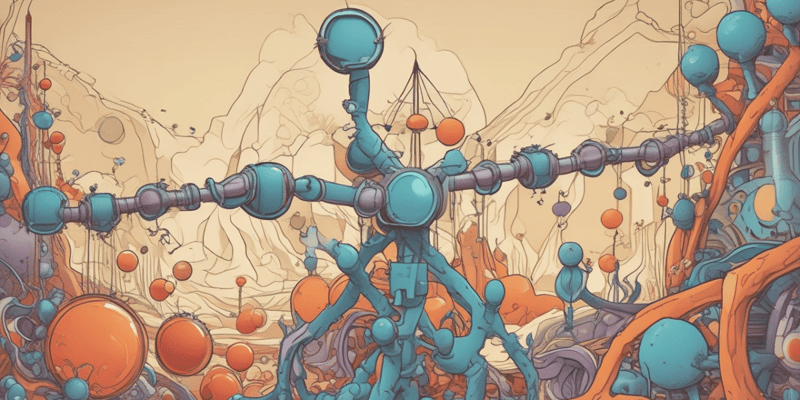Questions and Answers
What is the side chain of histidine depicted as?
Porphyrin
In which protein does dioxygen bind between two copper atoms?
Hemerythrin (Hr)
What type of reaction involves oxidative addition to the reduced form of the dimetallic center?
Oxidative addition
Which metalloprotein has a similar chemical strategy to Hc and Hr in terms of 02 binding?
Signup and view all the answers
What is one of the core principles of bioinorganic chemistry according to the text?
Signup and view all the answers
What do the realizations discussed in the text form the basis behind?
Signup and view all the answers
What is the primary focus of bioinorganic chemistry?
Signup and view all the answers
How are heavy metals like mercury and platinum utilized in bioinorganic chemistry?
Signup and view all the answers
What is one of the key applications of paramagnetic metal ions in bioinorganic chemistry?
Signup and view all the answers
Which of the following is NOT a current topic of investigation in bioinorganic chemistry?
Signup and view all the answers
What are the two major components of bioinorganic chemistry as mentioned in the text?
Signup and view all the answers
How are metal-containing compounds commonly used in bioinorganic chemistry?
Signup and view all the answers
What is the main purpose of bioinorganic chemistry as stated in the text?
Signup and view all the answers
Which metal ion is involved in nitrogen fixation, oxidase, and electron transfer functions?
Signup and view all the answers
What is the special class of metalloproteins that perform a catalytic function?
Signup and view all the answers
In which respiratory protein does the dioxygen-binding site involve an iron-porphyrin complex?
Signup and view all the answers
What is the specific function of hemocyanin in the text?
Signup and view all the answers
Which metal ion is essential for hydrolase activity and structure in biological systems?
Signup and view all the answers
What are the known classes of dioxygen-transport proteins mentioned in the text?
Signup and view all the answers
What is the primary function of sodium and potassium in biological systems according to the text?
Signup and view all the answers
Which metal ion is involved in photosynthesis, oxidase functions, and structure?
Signup and view all the answers
What distinguishes metalloenzymes from other proteins?
Signup and view all the answers
Study Notes
Bioinorganic Chemistry
- Bioinorganic chemistry is a discipline that combines inorganic chemistry and biology to study the role of inorganic elements in biological processes.
- Although biology is often associated with organic chemistry, inorganic elements are essential to life processes.
- Essential inorganic elements and their roles in biology include:
- Sodium: charge carrier, osmotic balance
- Potassium: charge carrier, osmotic balance
- Magnesium: structure, hydrolase, isomerase
- Calcium: structure, trigger, charge carrier
- Vanadium: nitrogen fixation, oxidase
- Chromium: dehydrogenase
- Manganese: photosynthesis, oxidase, structure
- Iron: oxidase, alkyl group transfer
- Cobalt: oxidase, alkyl group transfer
- Nickel: hydrogenase, hydrolase
- Copper: structure, hydrolase
- Zinc: structure, hydrolase
Metal Functions in Metalloproteins
- Metals are commonly found as natural constituents of proteins and perform specific functions associated with life processes.
- Metalloproteins that perform a catalytic function are called metalloenzymes.
- One function uniquely performed by metalloproteins is respiration, which involves dioxygen transport proteins.
- There are three known classes of dioxygen transport proteins:
- Hemoglobin-myoglobin family
- Hemocyanins
- Hemerythrins
- The functional metallic cores of these proteins are:
- Hemoglobin-myoglobin family: iron-porphyrin complex
- Hemocyanins: pair of copper atoms
- Hemerythrins: Fe2 unit
Dioxygen Transport
- Dioxygen transport proteins achieve a delicate balance between binding to the metal center without undergoing an irreversible electron transfer reaction.
- In hemoglobin and myoglobin, the dioxygen-binding site is an iron-porphyrin complex that undergoes structural changes upon oxygen binding.
- These structural changes trigger subtle movements of the protein chains, leading to cooperativity in the uptake of dioxygen.
- In hemocyanin and hemerythrin, the dioxygen-binding reaction involves oxidative addition to the reduced, or deoxy, form of the dimetallic center, generating the peroxide or hydroperoxide derivative of the oxidized form.
Studying That Suits You
Use AI to generate personalized quizzes and flashcards to suit your learning preferences.
Description
Explore the interdisciplinary field of bioinorganic chemistry that merges inorganic chemistry and biology. Learn about the essential inorganic elements and their roles in biological processes. Discover how bioinorganic chemists study these elements in vivo.




